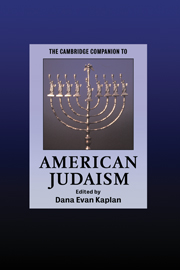Book contents
- Frontmatter
- Introduction
- Part I Historical overviews
- Part II Themes and concepts
- Section 1 Religious Culture and Institutional Practice
- 4 Jewish religious denominations
- 5 Patterns of American Jewish religious behavior
- 6 Thinking Judaism through
- 7 The essence of American Judaism
- 8 Contemporary Jewish education
- Section 2 Identity and Community
- Section 3 Living in America
- Section 4 Jewish Art in America
- Section 5 The Future
- Afterword
- Further reading
- Index
- Series list
4 - Jewish religious denominations
from Section 1 - Religious Culture and Institutional Practice
Published online by Cambridge University Press: 28 May 2006
- Frontmatter
- Introduction
- Part I Historical overviews
- Part II Themes and concepts
- Section 1 Religious Culture and Institutional Practice
- 4 Jewish religious denominations
- 5 Patterns of American Jewish religious behavior
- 6 Thinking Judaism through
- 7 The essence of American Judaism
- 8 Contemporary Jewish education
- Section 2 Identity and Community
- Section 3 Living in America
- Section 4 Jewish Art in America
- Section 5 The Future
- Afterword
- Further reading
- Index
- Series list
Summary
Denominational Judaism did not yet exist when Jews began settling in the American colonies during the seventeenth century. The primary dividing line between Jews at that time was ethnocultural - between Sephardim, who traced their ancestry to Spain or Portugal where their families had in many cases been forcibly converted to Catholicism, and Ashkenazim, who originated from German-speaking lands. Although synagogue ritual for both groups was meticulously traditional, individual religious behavior varied widely. In keeping with European precedent, each American community maintained only one official synagogue, run by a lay board. Since there were no ordained rabbis in the country, knowledgeable congregants conducted services. Gradually, the natural growth and increasing heterogeneity of the Jewish population, internecine conflict, and the American penchant for individualism and freedom of association splintered the unified Jewish communities and led to the founding of multiple congregations in the same city.
REFORM, THE FIRST DENOMINATION
Beginning in the 1830s and continuing through the Civil War, a stream of Jewish immigrants from German-speaking lands planted the first Jewish “denomination” in America, Reform. Although it was technically the Sephardi congregation, Beth Elohim of Charleston, South Carolina, that first espoused so-called Reform Judaism in the 1820s, the German newcomers made this form of Judaism the primary American expression of the religion until well into the twentieth century.
- Type
- Chapter
- Information
- The Cambridge Companion to American Judaism , pp. 81 - 100Publisher: Cambridge University PressPrint publication year: 2005
- 2
- Cited by



